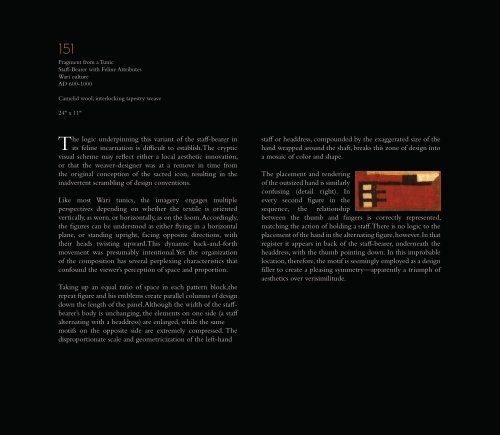You also want an ePaper? Increase the reach of your titles
YUMPU automatically turns print PDFs into web optimized ePapers that Google loves.
151<br />
Fragment from a Tunic<br />
Staff-Bearer with Feline Attributes<br />
Wari culture<br />
AD 600-1000<br />
Camelid wool; interlocking tapestry weave<br />
24" x 11"<br />
The logic underpinning this variant of <strong>the</strong> staff-bearer in<br />
its feline incarnation is difficult to establish.The cryptic<br />
visual scheme may reflect ei<strong>the</strong>r a local aes<strong>the</strong>tic innovation,<br />
or that <strong>the</strong> weaver-designer was at a remove in time from<br />
<strong>the</strong> original conception of <strong>the</strong> sacred icon, resulting in <strong>the</strong><br />
inadvertent scrambling of design conventions.<br />
Like most Wari tunics, <strong>the</strong> imagery engages multiple<br />
perspectives depending on whe<strong>the</strong>r <strong>the</strong> textile is oriented<br />
vertically, as worn, or horizontally, as on <strong>the</strong> loom. Accordingly,<br />
<strong>the</strong> figures can be understood as ei<strong>the</strong>r flying in a horizontal<br />
plane, or standing upright, facing opposite directions, with<br />
<strong>the</strong>ir heads twisting upward.This dynamic back-and-forth<br />
movement was presumably intentional.Yet <strong>the</strong> organization<br />
of <strong>the</strong> composition has several perplexing characteristics that<br />
confound <strong>the</strong> viewer’s perception of space and proportion.<br />
Taking up an equal ratio of space in each pattern block,<strong>the</strong><br />
repeat figure and his emblems create parallel columns of design<br />
down <strong>the</strong> length of <strong>the</strong> panel.Although <strong>the</strong> width of <strong>the</strong> staffbearer’s<br />
body is unchanging, <strong>the</strong> elements on one side (a staff<br />
alternating with a headdress) are enlarged, while <strong>the</strong> same<br />
motifs on <strong>the</strong> opposite side are extremely compressed. The<br />
disproportionate scale and geometricization of <strong>the</strong> left-hand<br />
staff or headdress, compounded by <strong>the</strong> exaggerated size of <strong>the</strong><br />
hand wrapped around <strong>the</strong> shaft, breaks this zone of design into<br />
a mosaic of color and shape.<br />
The placement and rendering<br />
of <strong>the</strong> outsized hand is similarly<br />
confusing (detail right). In<br />
every second figure in <strong>the</strong><br />
sequence, <strong>the</strong> relationship<br />
between <strong>the</strong> thumb and fingers is correctly represented,<br />
matching <strong>the</strong> action of holding a staff.There is no logic to <strong>the</strong><br />
placement of <strong>the</strong> hand in <strong>the</strong> alternating figure, however. In that<br />
register it appears in back of <strong>the</strong> staff-bearer, underneath <strong>the</strong><br />
headdress, with <strong>the</strong> thumb pointing down. In this improbable<br />
location, <strong>the</strong>refore, <strong>the</strong> motif is seemingly employed as a design<br />
filler to create a pleasing symmetry—apparently a triumph of<br />
aes<strong>the</strong>tics over verisimilitude.<br />
56







